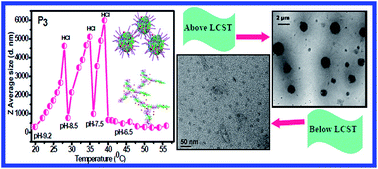Water soluble stimuli-responsive star copolymers with multiple encapsulation and release properties†
Abstract
A series of three arm star shaped (random/block) and linear water soluble copolymers are synthesised by atom transfer radical polymerization (ATRP) using di(ethylene glycol) methyl ether methacrylate (DEGMA) and 2-(dimethylamino) ethyl methacrylate (DMAEMA). The structure and composition of the block and random copolymers are characterized by 1H NMR spectra and gel permeation chromatography (GPC). The self-assembly of these copolymers, investigated by dynamic light scattering (DLS), exhibits that below the lower critical solution temperature (LCST) of pDEGMA all the copolymers are soluble in water and possess lower particle size but above its LCST particle size increases particularly in a basic medium. On addition of 8-anilino-1-naphthalenesulfonic acid (ANS) the particle size increases by ∼10 times below the LCST. Both the DLS and fluorescence studies using a hydrophobic fluorescent dye, exhibit temperature triggered encapsulation and pH triggered release. All the copolymers exhibit highly reversible multiple aggregation at different temperature and pH conditions and require increased temperature for the aggregation with decrease in pH of the medium. The random star copolymer [3-arm-p(DEGMA40-co-DMAEMA18)] exhibits aggregate formation under physiological conditions (37 °C and pH 7.5) and with decreasing the pH to 6.5 the aggregates dissociate. The MTT assay and cell morphology indicate that the three arm star and linear random copolymers have lower cytotoxicity against normal CHO-K1 cells having lower positive zeta potential values.


 Please wait while we load your content...
Please wait while we load your content...